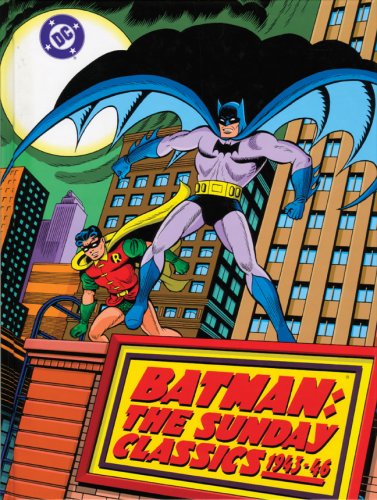Comic Strip Review: Batman: The Sunday Classics 1943-1946 by various creators
Batman was a big success in the comic books, so it wasn’t long at all before it was decided that he’d probably be a hit in the newspaper comic strips as well. Once that was decided, the problem of Sundays had to be considered. Many smaller newspapers didn’t have a Sunday edition, and often budget-conscious families would only buy the Sunday paper for its coupons and thick supplements and not see the daily strips. So some comic strips would simply skip Sundays, others would only run on Sundays, a third group used the Sunday to recap the week, and then there was a fourth method.

That method was having an entirely separate continuity for the Sunday pages of the comic strip, so that the stories didn’t have to intersect at all. This is the method the Batman strip took. The Sundays were usually penciled by Jack Burnley and inked by Charles Paris, with several writers, including Bill Finger. (The dailies were mostly Bob Kane on art.)
Ancillary material in this coffee table edition includes production notes for each of the stories, mini-bios of the various people who helped produce the strip (letterer Ira Schnapp has one paragraph that’s basically “we have nothing.”, marketing materials, essays on Batman as a liminal figure between heroes of the past and present and the influence Dick Tracy had on Batman, and looks at other attempts to bring Batman to the newspaper comics.
The stories themselves begin with the Penguin coming up with a clever scheme to rob the richest and most penny-pinching man in Gotham, Amos Q. Pinchbeck. This involves a bargain price on an umbrella that has a radio speaker inside, allowing Penguin to stick the miser up by remote control.
There’s also a story where we learn the Penguin’s real name and Batman and Robin have to protect him from the rest of the underworld. That name, Oswald Chesterfield Cobblepot, made it back into the comic book.
Other standout stories include ones where gangsters engage in an elaborate plot to make a police officer lose weight, Catwoman leads Batman and Robin on a wild chase across America, and a suspenseful race against time to discover the real murderer before a man on Death Row is executed.
There are a handful of stories featuring Alfred Beagle, Bruce Wayne’s butler. These are lighter-toned, as when Alfred decides to play Santa to an impoverished child, only to stumble into the wrong apartment just in time to save Batman’s life.
And then a couple of stories are lifted almost directly from the comic books, like “The Four Fates” in which four murderers are cursed to die, each with a prophecy twist. “Metal will still your beating heart.” “Ha, I wear a bullet-proof vest at all times.” (Dies of metal anyway.) And a version of Two-Face, but instead of being district attorney Harvey Kent, he’s vain actor Apollo Kent.
The stories are short, with several only being two Sunday pages long, but since they’re full Sunday pages, that’s still enough room to tell a story.
The final story is a two-parter about a criminal who leaves a deliberate clue to lure Batman and Robin into a trap. They turn the tables.
This is a pretty good run of all-ages Batman stories, though the non-gory deaths might be too intense for the youngest readers. They largely ignore the War going on, outside a rich man’s quick reference to donating to the War effort.
The art is excellent by Golden Age comics standards and this reprint does a good job with the colors. The large size also allows the format to shine. (This is one volume I would not recommend the e-book of.)
Highly recommended to Batman fans and collectors of old comic strips.

